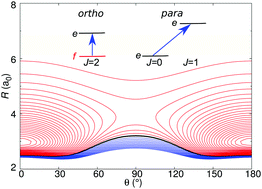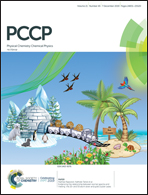Near dissociation states for H2+–He on MRCI and FCI potential energy surfaces†
Abstract
New potential energy surfaces (PES) have been constructed for H2+–He using a reproducing kernel Hilbert space (RKHS) representation from an extensive number of ab initio energies computed at the multi reference and full configuration interaction levels of theory. For the MRCI PES the long-range interaction region of the PES is described by analytical functions and is connected smoothly to the short range interaction region, represented as a RKHS. All bound ro-vibrational states for the ground electronic state of H2+–He are calculated using two different methods to determine quantum bound states. Comparing transition frequencies for the near-dissociation states for ortho- and para-H2+–He allows assignment of the 15.2 GHz line to a J = 2 e/f parity doublet of ortho-H2+–He whereas the experimentally determined 21.8 GHz line is only consistent with a (J = 0) → (J = 1) e/e transition in para-H2+–He.

- This article is part of the themed collection: 2019 PCCP HOT Articles


 Please wait while we load your content...
Please wait while we load your content...